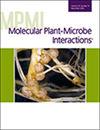Daniil M Prigozhin, Chandler A Sutherland, Sanjay Rangavajjhala, Ksenia V Krasileva
求助PDF
{"title":"Majority of the Highly Variable NLRs in Maize Share Genomic Location and Contain Additional Target-Binding Domains.","authors":"Daniil M Prigozhin, Chandler A Sutherland, Sanjay Rangavajjhala, Ksenia V Krasileva","doi":"10.1094/MPMI-05-24-0047-FI","DOIUrl":null,"url":null,"abstract":"<p><p>Nucleotide-binding, leucine-rich repeat (LRR) proteins (NLRs) are a major class of immune receptors in plants. NLRs include both conserved and rapidly evolving members; however, their evolutionary trajectory in crops remains understudied. Availability of crop pan-genomes enables analysis of the recent events in the evolution of this highly complex gene family within domesticated species. Here, we investigated the NLR complement of 26 nested association mapping (NAM) founder lines of maize. We found that maize has just four main subfamilies containing rapidly evolving highly variable NLR (hvNLR) receptors. Curiously, three of these phylogenetically distinct hvNLR lineages are located in adjacent clusters on chromosome 10. Members of the same hvNLR clade show variable expression and methylation across lines and tissues, which is consistent with their rapid evolution. By combining sequence diversity analysis and AlphaFold2 computational structure prediction, we predicted ligand-binding sites in the hvNLRs. We also observed novel insertion domains in the LRR regions of two hvNLR subfamilies that likely contribute to target recognition. To make this analysis accessible, we created NLRCladeFinder, a Google Colaboratory notebook, that accepts any newly identified NLR sequence, places it in the evolutionary context of the maize pan-NLRome, and provides an updated clade alignment, phylogenetic tree, and sequence diversity information for the gene of interest. [Formula: see text] Copyright © 2024 The Author(s). This is an open access article distributed under the CC BY 4.0 International license.</p>","PeriodicalId":19009,"journal":{"name":"Molecular Plant-microbe Interactions","volume":" ","pages":"275-284"},"PeriodicalIF":3.4000,"publicationDate":"2025-03-01","publicationTypes":"Journal Article","fieldsOfStudy":null,"isOpenAccess":false,"openAccessPdf":"","citationCount":"0","resultStr":null,"platform":"Semanticscholar","paperid":null,"PeriodicalName":"Molecular Plant-microbe Interactions","FirstCategoryId":"99","ListUrlMain":"https://doi.org/10.1094/MPMI-05-24-0047-FI","RegionNum":3,"RegionCategory":"生物学","ArticlePicture":[],"TitleCN":null,"AbstractTextCN":null,"PMCID":null,"EPubDate":"2024/11/23 0:00:00","PubModel":"Epub","JCR":"Q2","JCRName":"BIOCHEMISTRY & MOLECULAR BIOLOGY","Score":null,"Total":0}
引用次数: 0
引用
批量引用
Abstract
Nucleotide-binding, leucine-rich repeat (LRR) proteins (NLRs) are a major class of immune receptors in plants. NLRs include both conserved and rapidly evolving members; however, their evolutionary trajectory in crops remains understudied. Availability of crop pan-genomes enables analysis of the recent events in the evolution of this highly complex gene family within domesticated species. Here, we investigated the NLR complement of 26 nested association mapping (NAM) founder lines of maize. We found that maize has just four main subfamilies containing rapidly evolving highly variable NLR (hvNLR) receptors. Curiously, three of these phylogenetically distinct hvNLR lineages are located in adjacent clusters on chromosome 10. Members of the same hvNLR clade show variable expression and methylation across lines and tissues, which is consistent with their rapid evolution. By combining sequence diversity analysis and AlphaFold2 computational structure prediction, we predicted ligand-binding sites in the hvNLRs. We also observed novel insertion domains in the LRR regions of two hvNLR subfamilies that likely contribute to target recognition. To make this analysis accessible, we created NLRCladeFinder, a Google Colaboratory notebook, that accepts any newly identified NLR sequence, places it in the evolutionary context of the maize pan-NLRome, and provides an updated clade alignment, phylogenetic tree, and sequence diversity information for the gene of interest. [Formula: see text] Copyright © 2024 The Author(s). This is an open access article distributed under the CC BY 4.0 International license.
玉米中大多数高度可变的 NLRs 具有相同的基因组位置,并含有额外的目标结合域。
核苷酸结合富亮氨酸重复蛋白(NLRs)是植物中的一类主要免疫受体。NLRs 包括保守成员和快速进化成员,但它们在农作物中的进化轨迹仍未得到充分研究。有了作物泛基因组,就可以分析这一高度复杂的基因家族在驯化物种中的最新进化事件。在这里,我们研究了 26 个玉米嵌套关联图谱(NAM)创始品系的 NLR 互补。我们发现,玉米仅有四个主要亚家族包含快速进化的高变异 NLR(hvNLR)受体。奇怪的是,这些系统发育上不同的 hvNLR 系中有三个位于 10 号染色体上的相邻群中。同一 hvNLR 支系的成员在不同品系和组织中表现出不同的表达和甲基化,这与它们的快速进化是一致的。通过结合序列多样性分析和 AlphaFold2 计算结构预测,我们预测了 hvNLRs 中的配体结合位点。我们还在两个 hvNLR 亚家族的 LRR 区域观察到了新的插入域,这些插入域可能有助于目标识别。为了使这一分析易于访问,我们创建了谷歌实验室笔记本 NLRCladeFinder,它可以接受任何新鉴定的 NLR 序列,将其置于玉米泛 NLRome 的进化背景中,并为感兴趣的基因提供最新的支系排列、系统发生树和序列多样性信息。
本文章由计算机程序翻译,如有差异,请以英文原文为准。

 求助内容:
求助内容: 应助结果提醒方式:
应助结果提醒方式:


